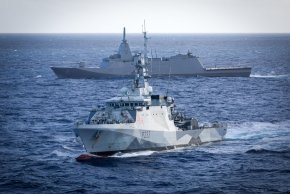kiwi in exile
Well-Known Member
With HMNZS Aotearoa being deployed to near N Korea i wonder if it will finally be fitted with a CIWS, likely from the frigates.
bwahahah you funny... don't be silly now...With HMNZS Aotearoa being deployed to near N Korea i wonder if it will finally be fitted with a CIWS, likely from the frigates.
Really escapes me why she was built for CIWS but has never 'worn' it!?!Well she arrived in Pearl Harbor today for exercises. No CIWS but the mini-typhoon can be seen behind the funnel.
x.com
x.com
Guess because it would then have to come off one of the frigates when they should be going through a period of getting them both upto standard, with all systems integrated, tested and signed off competent post refit. AO is away for the next half a year essentially so along time for half the combat fleet to be without its CIWS so perceived priorities perhaps? I would also assume it would involve added training, maintenance and perhaps even a couple of extra pers as I wouldn't think it's the kind of system you just throw on and push go? Not entirely sure though as like you say, its FFBNW and never has.Really escapes me why she was built for CIWS but has never 'worn' it!?!
The Mini Typhoons were installed when she first arrived in NZ a few years back ... better than nothing but really needs the Phalanx CIWSWell she arrived in Pearl Harbor today for exercises. No CIWS but the mini-typhoon can be seen behind the funnel.
x.com
x.com
The article also states the OPVs are mothballed. Is this the case?Interesting, but not unexpected.... NZDF reduces Seasprite helicopter fleet - Australian Defence Magazine
Basically taking 3 out of service to allow 5 operational.
As in Care and Custody. From the Annual Review of Vote Defence Force Feb 2024 (quotes below), the OPV's are under C&C by Babcock and are in capable hands (company wise and personnel wise - some are ex-RNZN).The article also states the OPVs are mothballed. Is this the case?
Didn’t Luxon just get a tour of the Mogami whilst in Japan?the case has been made by one former RNZN officer in the latest Line of Defence and at the June CSS Maritime Security symposium that NZs ANZAC replacement should be tied into the RANs plan to aquire 11 tier 2 naval combat ships.
Benefits: economy of scale tacking on to Australian order, interoperability, ability to cross crew, training and logistics support pipeline with Australia.
Shortlisted options for RAN tier 2 frigate as per wiki:
NB no type 31
- Spanish ALFA3000
- South Korean Daegu class FFX Batch II or Batch III
- German MEKO A-200
- Japanese Mogami 30FFM


Lots to like about the Mogami class - specifically it’s capability (surface to air, surface to surface and ASW) with a crew of approximately 90 (as I understand it). Given our recruitment and retention issues, this is a great option for NZ as we could likely find it easier to crew more (dare we say back to a 3 frigate Navy…). Is Australia considering the Mogami class as a Tier 2 frigate to supplement/offset the Hunter class…?Japan doesn't muck around when it comes to self-promotion of their capabilities, JS Noshiro (FFM-3) is currently visiting several South Pacific nations (as well as Australia and the US) and conducting port visits and exercises.
View attachment 51503
Pic source: @DefenceAust
Project Sea 3000: What we know - Australian Defence MagazineLots to like about the Mogami class - specifically it’s capability (surface to air, surface to surface and ASW) with a crew of approximately 90 (as I understand it). Given our recruitment and retention issues, this is a great option for NZ as we could likely find it easier to crew more (dare we say back to a 3 frigate Navy…). Is Australia considering the Mogami class as a Tier 2 frigate to supplement/offset the Hunter class…?
The Mogami will have a 32 cell mk 41 VLS as well plus the advantage of being regional with Japan if not Australia as well vs UK on the other side of the planet so there are certain synergies in its favour as well as some political element. I do like the Mogami, regardless of if Australia chooses it or not, due to its multi-role, high automation, features (ie that CIC alone!) and more importantly build cost benefits which added up could potentially equate to an easier sell of a 3 frigate purchase WITH options instead of the usual FFBNW option or a status quo 1 for 1 scenario. I see no point in spending $bns on frigates if they are essentially just expensive targets with limited/no eyes, ears, teeth or backbone.I understand the rationale for the ADF/RAN wanting to go for a proven off the shelf design, but it seems weird not to see the type 31 on the list. The 31 is designed to accommodate western weapons/systems, including possibly CEAFAR. Mogami etc would involve a certain amount of cost and risk fitting anglo systems. All of this is worth considering for rnzn plans. Plan ANZAC makes sense but on paper I would go for type 31 with the 32 cell mk 41 VLS as per the RN over the listed tier 2 candidates.
